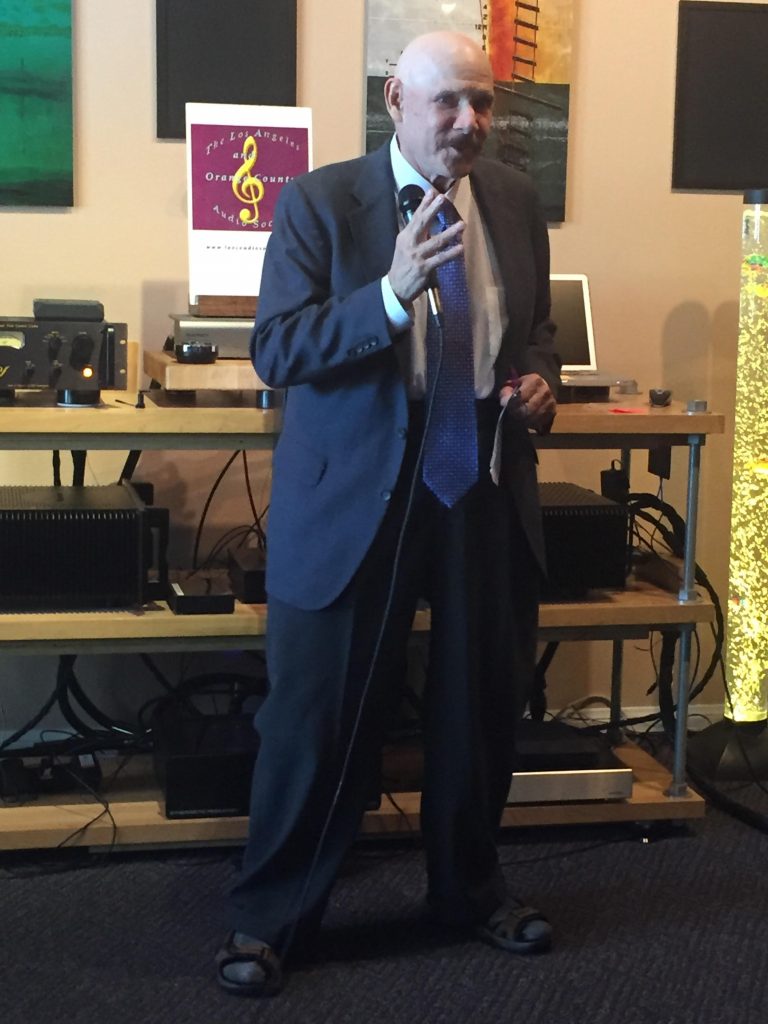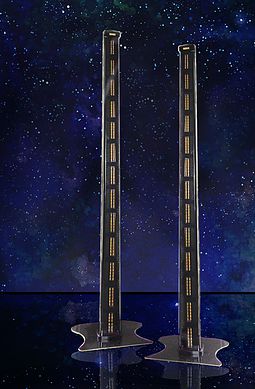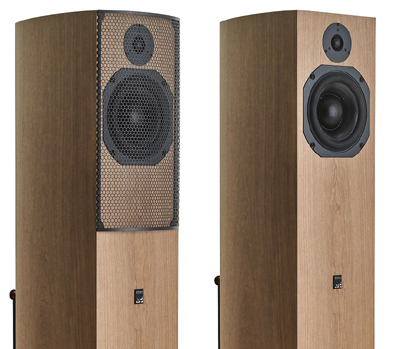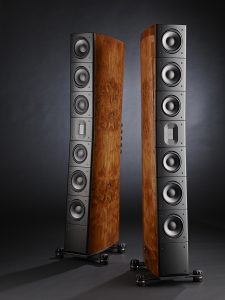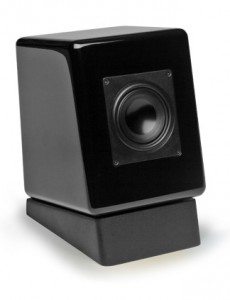On Sunday October 15, 2017, the Los Angeles and Orange County Audio Society held its monthly meeting at the beautiful Weinhart Design audio emporium in Bel Air, CA. The main draw for this meeting was an opportunity to audition the Carver Amazing Line Source (ALS) Speakers from the Bob Carver Corporation. But, not only would we hear music from these wonderful speakers, we would hear all about them from the legendary Bob Carver himself. And, to top it off, Bob donated a pair of his Crimson 350 monoblock amplifiers that list for $9500 to a raffle coming at the end of the event. Wow, what a meeting! More than 100 California audiophiles turned out on a hot afternoon in one of the nicer neighborhoods in Los Angeles for this sonic fest. Including, four other writers for Positive Feedback and Robert E. Greene from The Absolute Sound.
First, about the speakers and setup. As you may remember if you read Mr. Greene's review in The Absolute Sound, these speakers are a quite unique implementation of a line source. Each speaker consists of 13 front-firing ribbon drivers in an 89-inch tall extruded aluminum tower. Also, nine small cone drivers fire laterally on each side of the tower to perform multiple functions including cancellation of interaural stereo signals that smear images. There is also a single small ribbon driver at the top of the tower that adds some spatial ambiance. Each pair of speakers comes with a single Carver SubRosa subwoofer that extends the low end response to 18Hz. This combination sells for $18,500 and is built entirely in the USA. In the setup at Weinhart's, the SubRosa subwoofer was set aside in favor of two very large REL subwoofers. Amplifiers were Bryston 1kW monoblocks driven by an E.A.R. 912 preamp. While I was in the room we only listened to vinyl sources, although a complete digital set up was also on call.
I had the opportunity to listen for about 20 minute,s but in a room crowded with around 60 other people, so far from perfect conditions. I was sitting about 15 feet from the speaker plane, just inside the left speaker. Even in this off-center location the amazingly precise imaging characteristics of the speaker was clearly evident. The sound stage was broad, deep, and completely defined. Individual instruments and voices could be located exactly in the sound space and stayed put no matter what frequency range was excited. The speakers, of course, disappeared completely as should be expected from a line source, but not always achieved in other designs. Dynamics were lightning fast al all volume levels and the sound was amazingly (can't avoid using that word) transparent and airy. There was no sense of listening to a speaker at all, rather just instruments playing in an acoustic space. The musical flow was coherent and involving. We didn't listen to any music with powerful bass, but what was there was refined and believably defined. In fact, believable would be another adjective Carver could use to characterize these speakers other than amazing. They make music sound believable played in a real place. Everything I heard was very satisfying, although I did think the tonal balance was tipped up a little in the treble. Each ALS has an outboard crossover that sits on the floor behind the speakers. The crossover has three rotary controls for the lows, mids, and highs and I noticed all controls were set near the top of their ranges. Maybe that was why things sounded a bit too hot for my taste, but the overall impression of this imperfect demonstration was of sitting in a concert venue with 60 other souls listening to a live performance. One couldn't ask for more.
I had a few minutes before the formal meeting started to speak to Bob Carver. He is one of my idols in this industry because of his fertile, inventive mind, and his passion for both music and the technology behind it. We chatted about some of the many innovations contained within the ALS. For example, I asked him how the front firing ribbons were connected, i.e., were they all fed the same signal which would produce a fairly narrow sound beam in the vertical plane, broad in the horizontal plane, and centered about the middle of the speaker in height. He said, no, that he felt the image had to be raised a bit to be realistic. What was fascinating was what he told me about how he came to this conclusion. He said he brought in several vocalists to his sound room and had them sing while standing or sitting in between the speakers while he listened. Once he determined this way that the image height had to be raised he devised a scheme to feed each of the 13 ribbon drivers a slightly different signal in both amplitude and phase. He fine-tuned this empirically-derived feed approach by inviting the singers back and comparing their music in a live versus recorded demonstration. A genius at work.
During Bob Carver's talk before demonstrating the speakers (he conducted two separate demos to accommodate the large crowd), he told an interesting story about how to start an amplifier company. You probably know that Bob made a splash on the audio scene with his first product, the Phase Linear 700 amplifier back in the early 1970s. This was the most powerful solid state amplifier of its time (350 W/channel) and sold for a remarkably low price of $749. Bob told us his knowledge of high power amplifiers came from a project he led while a graduate student in Canada, working for the University of Washington who had a contract with Boeing. He was charged to produce a massively powerful amplifier to drive a huge set of speakers that could simulate the volume level of a jet aircraft taking off.
Bob's inspiration for the Phase Linear 700 for consumer audio was a similarly high-power tube amp from McIntosh that cost in the thousands. He thought he could build a better, cheaper amplifier with transistors. To get going he built a prototype and took it to one of the McIntosh amplifier clinics where they would measure the frequency response and distortion versus power of any amplifier the interested audio consumer brought in. Bob knew that the McIntosh name and their clinics had great credibility. The McIntosh folks kindly ran a set of measurement data on Bob's amp and gave him a printout. Next, he ran a small ad about his amplifier in Audio Magazine which generated a huge response on those small punch cards we all used to fill out in those days (remember them?) requesting information. Bob and his wife personally responded to these by sending each party a copy of the McIntosh data. Many consumers took this information to their local audio dealers and asked if they carried Bob's amp, generating quite a demand. At this time Bob did not have the money to build even one amplifier. However, he did hook up with someone who was familiar with the then-current audio distribution supply lines who helped Bob out. Bob learned to tell dealers that called they had to order at least three amplifiers: "one to show and two to go." That is, one for demonstration purposes and two to sell. Bob used the advance money from these deals to buy the parts for his first amplifiers. He was fortunate in knowing some people who were willing to build the amplifiers with no wages initially, they just did it for fun. This is how he eventually raised the capital to fill all his orders and get his first company going. Bob did not know for sure but calculated that he probably sold about 50,000 of the Phase Linear series of amplifiers before the company was sold. This was a truly inspiring story that grabbed my interest since I have an entrepreneurial spirit similar to Bob's, but lack his courage and conviction. Bob Carver is an amazing man and one of the few geniuses in the audio world. It was an honor and immense pleasure to spend a few hours with him and one of his ear-opening products.
Carver Amazing Line Source
MSRP $18,500 including one subwoofer




